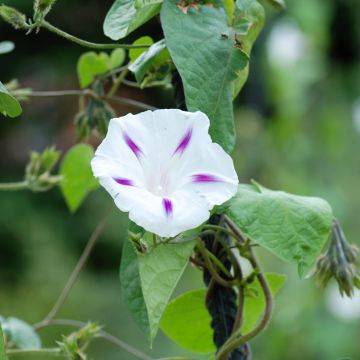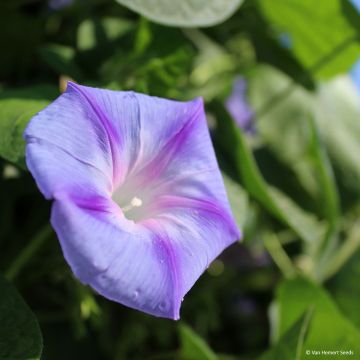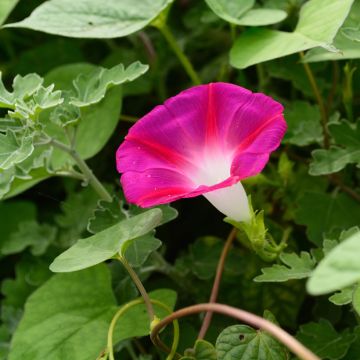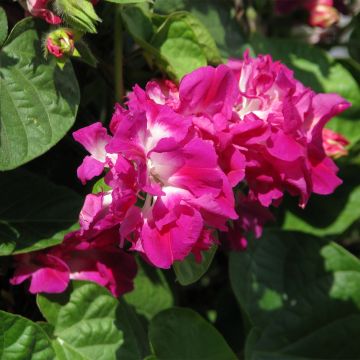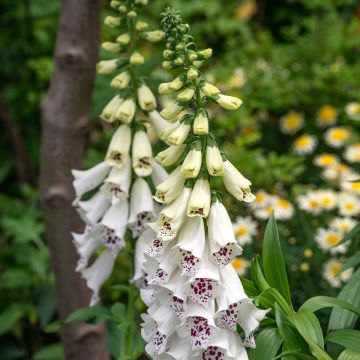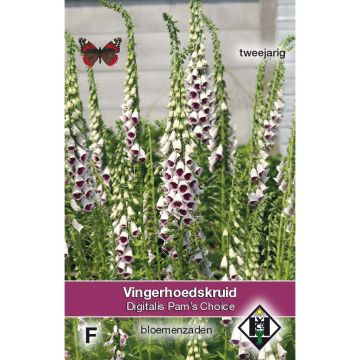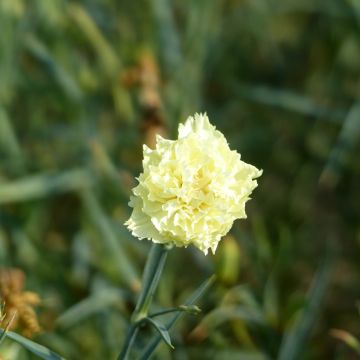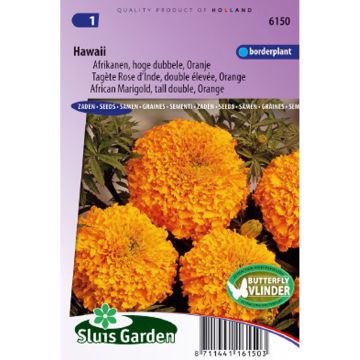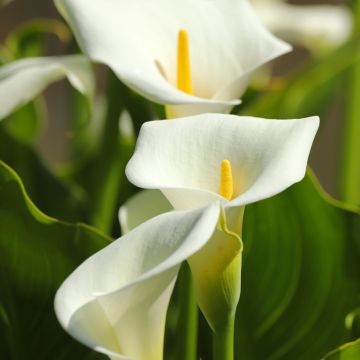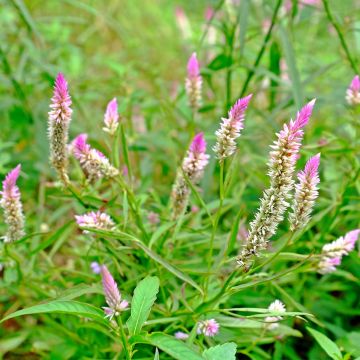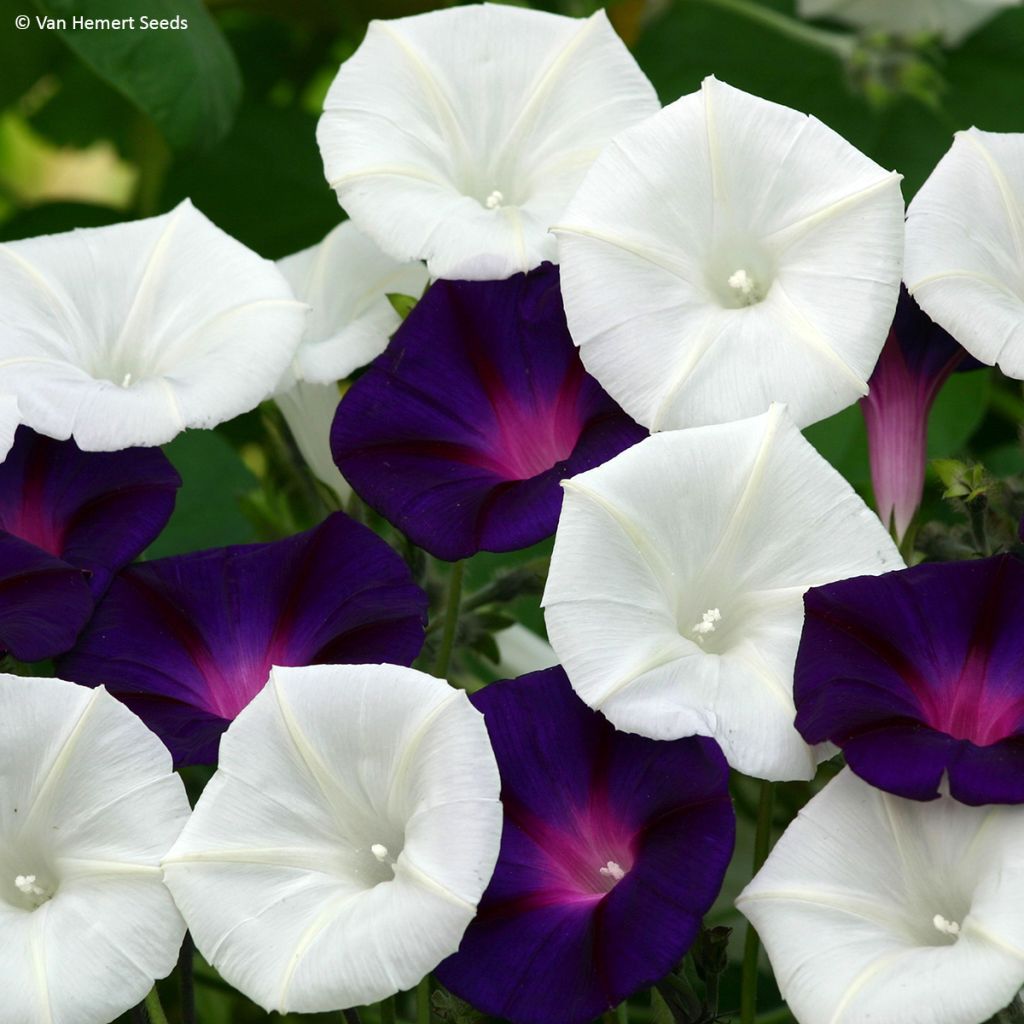

Ipomoea purpurea 'Shadow Dance'
Ipomoea purpurea 'Shadow Dance'
Ipomoea purpurea Shadow Dance
Common Morning Glory, Tall Morning Glory
This item cannot be shipped to the selected country
Dispatch by letter from €3.90
More information
Schedule delivery date,
and select date in basket
This plant carries a 6 months recovery warranty
More information
We guarantee the quality of our plants for a full growing cycle, and will replace at our expense any plant that fails to recover under normal climatic and planting conditions.
Seed-only orders are dispatched by sealed envelope. The delivery charge for seed-only orders is €3.90.
Does this plant fit my garden?
Set up your Plantfit profile →
Description
The 'Shadow Dance' Morning Glory is a selection that brings together two varieties of Ipomoea purpurea with remarkably contrasting colours, in white and very dark purple. Each plant develops long climbing stems loaded with buds that open on beautiful heart-shaped foliage in a season. Whether in the ground or in pots, this magnificent duo will compose astonishing ground covers and form superb flowering garlands on any support available.
The 'Shadow Dance' Morning Glory, is a very vigorous climbing plant from the Convolvulaceae family. The botanical species Ipomoea purpurea has origins that can be traced back to the tropical regions of America, probably Mexico. A perennial with a tuberous root, it is not frost-hardy in our climate and is cultivated as an annual. The growth of this plant is very fast: it sends its long climbing stems, reaching 2.50m (8ft), to climb any support within its reach. The flowering is long and abundant, from July until the first frost. In the 'Shadow Dance' selection, the funnel-shaped corollas measure 4 to 6cm (2in) in diameter. The first variety produces flowers in pure white, while the second produces dark purple flowers streaked with black around a pinkish-purple centre. Although these flowers close permanently in the afternoon, they constantly renew themselves on the plant. The climbing stems bear oval to heart-shaped leaves, 5 to 10cm (2 to 4in) long, rarely trilobed, in a matte dark green colour. Each plant produces about 100 pods filled with seeds, totaling around 600 seeds, at the end of the season, before the first frost. These can be harvested for sowing the following year, but plants grown from seeds are not necessarily identical to the parent plant.
This distant cousin of the common garden bindweed does not withstand our harsh winters, but that matters little in light of its rampant growth. The 'Shadow Dance' Morning Glory thrives in any well-drained, rich soil that remains slightly moist. Sow it in a warm and sunny location to make the most of its flowering. You can associate it with other ephemeral climbers such as Sweet Peas or Nasturtiums. It voluptuously wraps around trellises, pergolas, obelisks, balcony grilles, trees and bushes, clematis or even wisteria... and if it doesn't find support, it will run along the ground. It's an ideal plant to embellish an old wall, a dead tree...
Report an error about the product description
Flowering
Foliage
Plant habit
Botanical data
Ipomoea
purpurea
Shadow Dance
Convolvulaceae
Common Morning Glory, Tall Morning Glory
Convolvulus purpureus, Pharbitis purpurea
Cultivar or hybrid
Other Ipomoea seeds
Planting and care
From May to June, sow your 'Shadow Dance' Ipomoea in open ground or in a large pot. Soak the seeds in a bowl of water for 24 hours before sowing to accelerate seed germination.
Make small holes 1cm (0in) deep, spaced 50cm (20in) to 1m (3ft) apart. Place 4 or 5 seeds in each hole, then cover and water them.
It takes 18 days to see the first shoots emerge from the ground.
To save time on flowering, you can sow in March-April in pots at a temperature of 18°C (64.4°F), then transplant your plants to the garden after the last frost.
In summer, make sure your Ipomoea plants do not lack water, as this would harm their beautiful flowering. Water preferably in the early morning or evening. Avoid hot locations, as the foliage wilts quickly and the heat dehydrates the plants. You can remove faded flowers so that the plant does not exhaust itself by producing seeds. Ipomoea are so fertile that the first seeds that fall to the ground can quickly germinate and form new young plants before winter.
The soil should not be excessively rich in nitrates (nitrogen), as this would promote foliage development at the expense of flowering.
Sowing period
Intended location
This item has not been reviewed yet - be the first to leave a review about it.
Flower seeds
Haven't found what you were looking for?
Hardiness is the lowest winter temperature a plant can endure without suffering serious damage or even dying. However, hardiness is affected by location (a sheltered area, such as a patio), protection (winter cover) and soil type (hardiness is improved by well-drained soil).

Photo Sharing Terms & Conditions
In order to encourage gardeners to interact and share their experiences, Promesse de fleurs offers various media enabling content to be uploaded onto its Site - in particular via the ‘Photo sharing’ module.
The User agrees to refrain from:
- Posting any content that is illegal, prejudicial, insulting, racist, inciteful to hatred, revisionist, contrary to public decency, that infringes on privacy or on the privacy rights of third parties, in particular the publicity rights of persons and goods, intellectual property rights, or the right to privacy.
- Submitting content on behalf of a third party;
- Impersonate the identity of a third party and/or publish any personal information about a third party;
In general, the User undertakes to refrain from any unethical behaviour.
All Content (in particular text, comments, files, images, photos, videos, creative works, etc.), which may be subject to property or intellectual property rights, image or other private rights, shall remain the property of the User, subject to the limited rights granted by the terms of the licence granted by Promesse de fleurs as stated below. Users are at liberty to publish or not to publish such Content on the Site, notably via the ‘Photo Sharing’ facility, and accept that this Content shall be made public and freely accessible, notably on the Internet.
Users further acknowledge, undertake to have ,and guarantee that they hold all necessary rights and permissions to publish such material on the Site, in particular with regard to the legislation in force pertaining to any privacy, property, intellectual property, image, or contractual rights, or rights of any other nature. By publishing such Content on the Site, Users acknowledge accepting full liability as publishers of the Content within the meaning of the law, and grant Promesse de fleurs, free of charge, an inclusive, worldwide licence for the said Content for the entire duration of its publication, including all reproduction, representation, up/downloading, displaying, performing, transmission, and storage rights.
Users also grant permission for their name to be linked to the Content and accept that this link may not always be made available.
By engaging in posting material, Users consent to their Content becoming automatically accessible on the Internet, in particular on other sites and/or blogs and/or web pages of the Promesse de fleurs site, including in particular social pages and the Promesse de fleurs catalogue.
Users may secure the removal of entrusted content free of charge by issuing a simple request via our contact form.
The flowering period indicated on our website applies to countries and regions located in USDA zone 8 (France, the United Kingdom, Ireland, the Netherlands, etc.)
It will vary according to where you live:
- In zones 9 to 10 (Italy, Spain, Greece, etc.), flowering will occur about 2 to 4 weeks earlier.
- In zones 6 to 7 (Germany, Poland, Slovenia, and lower mountainous regions), flowering will be delayed by 2 to 3 weeks.
- In zone 5 (Central Europe, Scandinavia), blooming will be delayed by 3 to 5 weeks.
In temperate climates, pruning of spring-flowering shrubs (forsythia, spireas, etc.) should be done just after flowering.
Pruning of summer-flowering shrubs (Indian Lilac, Perovskia, etc.) can be done in winter or spring.
In cold regions as well as with frost-sensitive plants, avoid pruning too early when severe frosts may still occur.
The planting period indicated on our website applies to countries and regions located in USDA zone 8 (France, United Kingdom, Ireland, Netherlands).
It will vary according to where you live:
- In Mediterranean zones (Marseille, Madrid, Milan, etc.), autumn and winter are the best planting periods.
- In continental zones (Strasbourg, Munich, Vienna, etc.), delay planting by 2 to 3 weeks in spring and bring it forward by 2 to 4 weeks in autumn.
- In mountainous regions (the Alps, Pyrenees, Carpathians, etc.), it is best to plant in late spring (May-June) or late summer (August-September).
The harvesting period indicated on our website applies to countries and regions in USDA zone 8 (France, England, Ireland, the Netherlands).
In colder areas (Scandinavia, Poland, Austria...) fruit and vegetable harvests are likely to be delayed by 3-4 weeks.
In warmer areas (Italy, Spain, Greece, etc.), harvesting will probably take place earlier, depending on weather conditions.
The sowing periods indicated on our website apply to countries and regions within USDA Zone 8 (France, UK, Ireland, Netherlands).
In colder areas (Scandinavia, Poland, Austria...), delay any outdoor sowing by 3-4 weeks, or sow under glass.
In warmer climes (Italy, Spain, Greece, etc.), bring outdoor sowing forward by a few weeks.

































